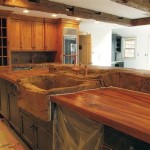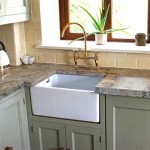What Is Cultured Marble Countertop?
Cultured marble countertops represent a manufactured alternative to natural marble, offering a blend of aesthetics and functionality at a potentially lower price point. This engineered material has gained considerable popularity in residential and commercial spaces, particularly in bathrooms and kitchens where durability and ease of maintenance are highly valued attributes. Understanding the composition, manufacturing process, and characteristics of cultured marble is crucial for anyone considering it as a countertop option.
Cultured marble is not a naturally occurring stone. It is a composite material created by combining crushed marble or limestone with a polyester resin and pigments. This mixture is then cast into molds to create various shapes and sizes, most commonly countertops, vanity tops, shower surrounds, and bathtubs. The pigments added during the mixing process allow for a wide range of colors and patterns, mimicking the look of natural marble or creating entirely unique designs.
The appeal of cultured marble lies in its ability to replicate the luxurious appearance of natural marble while offering some practical advantages, such as lower cost, greater consistency in color and veining, and a non-porous surface. However, it's important to be aware of its limitations and differences compared to natural stone before making a decision.
Key Components and Manufacturing Process
The creation of cultured marble countertops is a multi-stage process involving precise mixing, casting, and finishing. The quality and durability of the final product are significantly influenced by the proportions and types of materials used, as well as the adherence to proper manufacturing techniques.
The primary components in cultured marble are:
*Crushed Marble or Limestone:
This forms the bulk of the material, providing the stone-like appearance and contributing to the overall strength. The quality and fineness of the crushed stone can vary depending on the manufacturer and desired aesthetic. Finer particles generally result in a smoother surface finish. *Polyester Resin:
This acts as the binder, holding the crushed stone together and providing the necessary structural integrity. The type of resin used can affect the countertop's resistance to heat, staining, and impact. Higher-quality resins contribute to a more durable and longer-lasting product. *Catalysts and Accelerators:
These chemical additives are used to initiate and control the curing process of the polyester resin. They ensure that the resin hardens properly within a reasonable timeframe. *Pigments:
These are added to the mixture to impart color and create the desired veining patterns. The selection and blending of pigments are critical in achieving a realistic or artistic marble effect. *Fillers:
Sometimes, fillers such as calcium carbonate or silica are added to reduce costs or improve certain properties like scratch resistance. However, excessive use of fillers can compromise the overall strength and durability of the cultured marble.The manufacturing process typically involves the following steps:
1.Mixing:
The crushed marble or limestone, polyester resin, catalysts, accelerators, pigments, and any fillers are thoroughly mixed in precise proportions. This step is crucial for ensuring a consistent color and texture throughout the final product. 2.Pouring:
The mixture is then poured into molds that are designed to the desired shape and size of the countertop. The molds are usually made of fiberglass or other durable materials that can withstand the pressure and heat generated during the curing process. 3.Curing:
The filled molds are placed in a controlled environment, such as a curing oven, to allow the polyester resin to harden. The curing process can take several hours or even days, depending on the specific resin used and the size of the countertop. 4.Demolding:
Once the resin has fully cured, the countertop is removed from the mold. 5.Finishing:
The surface of the countertop is then polished to achieve the desired level of shine and smoothness. This process may involve multiple stages of sanding and polishing with progressively finer grits. 6.Sealing (Optional):
Some manufacturers apply a sealant to the surface of the cultured marble to further enhance its stain resistance and protect it from moisture. However, cultured marble is inherently non-porous, so sealing is not always necessary.The consistency of the materials and the precision of the manufacturing processes are critical to the quality of the finished cultured marble countertop. Variations in these factors can lead to inconsistencies in color, texture, and durability.
Advantages of Cultured Marble Countertops
Cultured marble countertops offer several advantages that make them a popular choice for many applications. These include:
*Cost-Effectiveness:
Compared to natural marble, cultured marble is significantly more affordable. This makes it an attractive option for those who desire the look of marble without the high price tag. The lower cost stems from the readily available materials and the efficient manufacturing process. *Non-Porous Surface:
Unlike natural marble, cultured marble is non-porous. This means that it is resistant to staining and bacterial growth. Liquids and spills will not penetrate the surface, making it easier to clean and maintain. This characteristic is particularly desirable in bathrooms and kitchens where spills are common. *Customization:
Cultured marble can be manufactured in a wide range of colors, patterns, and shapes. The pigments added during the mixing process allow for endless design possibilities, from replicating the veining of natural marble to creating entirely unique and artistic looks. The ability to customize the shape and size of the countertop to fit specific space requirements is another significant advantage. *Seamless Integration:
Cultured marble can be molded to include integral sinks and backsplashes, creating a seamless and hygienic surface. This eliminates the need for separate sink installations and reduces the risk of water damage around the sink area. The seamless design also contributes to a cleaner and more modern aesthetic. *Ease of Maintenance:
Cultured marble is relatively easy to clean and maintain. Regular cleaning with a mild soap and water is usually sufficient to keep the surface looking its best. The non-porous surface prevents the absorption of stains and makes it resistant to mildew and mold growth. *Consistent Appearance:
Unlike natural marble, which can vary significantly in color and veining, cultured marble offers a more consistent appearance. This is because the manufacturing process allows for precise control over the color and pattern of the material. This consistency can be desirable for those who prefer a uniform and predictable look.While cultured marble offers many advantages, it's important to consider its limitations before making a final decision.
Limitations and Considerations
Despite its advantages, cultured marble also has some limitations that potential buyers should be aware of:
*Susceptibility to Scratches:
While relatively durable, cultured marble is susceptible to scratches from abrasive cleaners or sharp objects. Care should be taken to avoid using harsh chemicals or abrasive cleaning pads. Cutting directly on the surface should be avoided. *Heat Sensitivity:
Cultured marble is not as heat-resistant as natural stone. Placing hot pots or pans directly on the surface can cause damage, such as discoloration or cracking. It is advisable to use trivets or heat-resistant mats to protect the countertop from high temperatures. *Repair Challenges:
While minor scratches can sometimes be buffed out, more significant damage to cultured marble can be difficult to repair. Matching the color and pattern of the original surface can be challenging, and the repair may be visible. *Lower Resale Value:
Compared to natural stone countertops, cultured marble may not add as much value to a home's resale value. While it is a functional and aesthetically pleasing option, it is generally perceived as a less luxurious material than natural marble, granite, or quartz. *Potential for Yellowing:
Over time, some cultured marble surfaces may develop a yellowish tint, especially if exposed to direct sunlight or frequent use of certain cleaning products. This yellowing can be more noticeable in lighter-colored countertops. *Not Environmentally Friendly:
The manufacturing process of cultured marble involves the use of polyester resin, a petroleum-based product. This makes it less environmentally friendly than natural stone, which is a naturally occurring material. *Aesthetic Limitations:
While cultured marble can mimic the look of natural marble, it may not have the same depth, complexity, and natural variations that are characteristic of real stone. Some people may find the appearance of cultured marble to be less authentic or luxurious than natural marble.When considering cultured marble countertops, it is important to weigh these limitations against the advantages and to choose a reputable manufacturer that uses high-quality materials and adheres to proper manufacturing techniques. Proper care and maintenance can help to extend the lifespan and maintain the appearance of cultured marble countertops.
The final decision on whether or not to install cultured marble countertops should be based on individual needs, preferences, and budget constraints. Careful consideration of the pros and cons will ensure that the choice is the best one for the specific application.

Cultured Marble Countertops An Overview R D Conroe Tx

Difference Between Real And Cultured Marble Chome

Cultured Marble Vs Granite Choosing The Best Material In 2025 Com

Is Cultured Marble The Right Choice For My Bathroom

Marble Like Quartz Cultured Countertops

Cultured Marble Kitchen Bath Center

Cultured Marble Countertops Metropolitan Cabinets

Cultured Marble Countertops Showers Review

Caring For Your Cultured Marble Countertops R D Inc

Cultured Marble Vs Corian Quartz Granite Countertops
See Also








